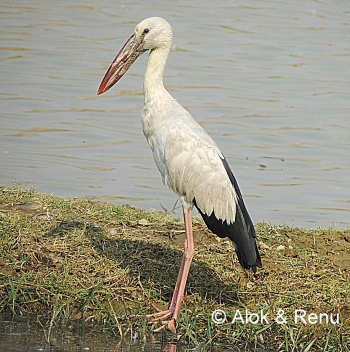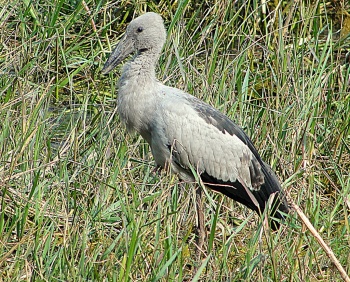Aloktewari (talk | contribs) (Image of pair in breeding plumage.) |
Aloktewari (talk | contribs) (Image of non-breeding adult) |
||
| Line 13: | Line 13: | ||
==Distribution== | ==Distribution== | ||
[[Asia]]: found in the lowlands of the [[India|Indian]] subcontinent to south-eastern [[Asia]] | [[Asia]]: found in the lowlands of the [[India|Indian]] subcontinent to south-eastern [[Asia]] | ||
| + | [[Image:asian_openbill_alok_2.JPG|thumb|350px|right|Adult in non-breeding plumage<br />Photo by {{user|aloktewari|Alok Tewari}}<br />Dighal Village, Dist. Jhajjar, Haryana, [[India]], November-2014]] | ||
==Taxonomy== | ==Taxonomy== | ||
This is a [[Dictionary_M-O#M|monotypic]] species<sup>[[#References|[1]]]</sup>. | This is a [[Dictionary_M-O#M|monotypic]] species<sup>[[#References|[1]]]</sup>. | ||
Revision as of 04:51, 6 November 2017
Alternative name: Asian Openbill Stork.

Pair in breeding plumage
Photo by Alok Tewari
Keoladeo National Park, Bharatpur, Rajasthan, India, July-2015
Photo by Alok Tewari
Keoladeo National Park, Bharatpur, Rajasthan, India, July-2015
- Anastomus oscitans
Identification
68cm.
- Mainly white
- Black flight feathers
- Red legs
- Dull yellowish-grey bill (visible gap between mandibles)
Non-breeding adult: off-white plumage
Young birds plumage has a brown tinge
Distribution
Asia: found in the lowlands of the Indian subcontinent to south-eastern Asia

Adult in non-breeding plumage
Photo by Alok Tewari
Dighal Village, Dist. Jhajjar, Haryana, India, November-2014
Photo by Alok Tewari
Dighal Village, Dist. Jhajjar, Haryana, India, November-2014
Taxonomy
This is a monotypic species[1].
Habitat
Marshy areas, lakes, wet and dry fields with trees for nesting.
Behaviour
Breeding
Two to six eggs are laid in stick nests placed in trees.
Diet
The diet includes molluscs, frogs and large insects.
References
- Clements, J. F., T. S. Schulenberg, M. J. Iliff, D. Roberson, T. A. Fredericks, B. L. Sullivan, and C. L. Wood. 2014. The eBird/Clements checklist of birds of the world: Version 6.9., with updates to August 2014. Downloaded from http://www.birds.cornell.edu/clementschecklist/download/
- Wikipedia
- BF Member observations
Recommended Citation
- BirdForum Opus contributors. (2024) Asian Openbill. In: BirdForum, the forum for wild birds and birding. Retrieved 12 May 2024 from https://www.birdforum.net/opus/Asian_Openbill
External Links





